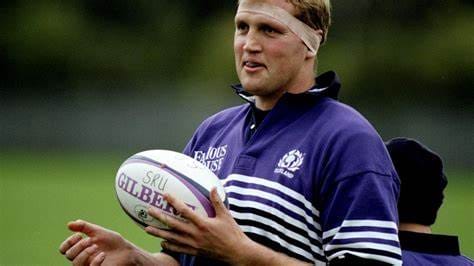The Giant Who Would Not Sit Still: Doddie Weir’s Fight Beyond the Pitch

In the pantheon of rugby’s hard men, there are plenty who played through broken fingers, fractured jaws, or torn muscles. Doddie Weir, the towering Scottish lock with the haystack hair and grin wide as a rugby post, went one further. When life handed him a terminal diagnosis—motor neuron disease—he laced his boots again, not for another match, but for a war against time itself.
This is not simply a story of an athlete struck down in retirement. It is the story of a man who refused to go quietly—who turned his own body into a battlefield, not just to endure a disease, but to drag it into the light and demand the world pay attention.
A Legend of the Lineout
George Wilson "Doddie" Weir stood 6’6” and weighed 114 kilograms during his playing career. His physicality made him a natural at lock, but it was his athleticism and offbeat energy that made him unforgettable. “He had the hands of a stand-off and the feet of a centre,” said former Scotland coach Jim Telfer in a 2019 BBC tribute. “He didn’t play the game; he galloped through it.”
Weir earned 61 caps for Scotland between 1990 and 2000, debuting against Argentina and soon becoming a staple of the forward pack. He played in three Rugby World Cups, represented the British and Irish Lions in 1997, and brought a loose-limbed joy to a role often defined by brute strength alone. His selection for the Lions tour was cruelly cut short by a serious knee injury following a dangerous tackle, a moment that robbed the world of his prime years on the international stage.
At Newcastle Falcons, he was a core member of the side that won the 1997–98 Premiership—a team that included Jonny Wilkinson and Inga Tuigamala. Weir's lineout control and infectious team spirit were foundational to their success. Off the pitch, he was famously self-deprecating. “You’d be amazed how often you need a 6’6” man to dress up as a daffodil,” he once said.
The Diagnosis That Changed the Narrative
In June 2017, Doddie Weir announced he had been diagnosed with motor neuron disease (MND), also known as ALS. MND gradually robs the body of muscle control, leaving the mind intact while the body deteriorates. The average life expectancy after diagnosis is just 2 to 5 years according to the Motor Neurone Disease Association (MNDA).
Rather than disappear, Weir responded with urgency. Within months, he and his family launched the My Name’5 Doddie Foundation, named after the number he often wore. The foundation aimed to fund research for a cure and provide support for those living with the disease.
Since its founding in late 2017, the Foundation has raised over £15 million, according to financial disclosures. It has funded more than 30 research projects, helped fast-track Edaravone drug trials in the UK, and distributed over £2.5 million in grants to families.
Weir testified before Parliament in 2021, demanding the UK Government deliver on its promises to fund neurological disease research. His advocacy was instrumental in securing £50 million in MND research funding as part of the UK Government’s Life Sciences Vision.
Dying to Make a Difference
Public awareness of MND in the UK rose by 37% from 2017 to 2021, according to a 2022 study in The Lancet Neurology, which directly credited Weir's media presence and foundation work. Neurologists like Professor Ammar Al-Chalabi of King’s College London have said Weir "did more for MND in five years than we had in decades."
Weir continued to make appearances at charity events, rugby matches, and fundraisers long after his mobility and speech began to fade. In 2019, he participated in a charity cycle event while wearing his signature tartan suit, pedaling with assistance to raise both funds and morale.

Rob Wainwright, his former Scotland teammate and the organizer of Doddie Aid, a nationwide fitness fundraiser, recalled: “We asked him if he wanted to just do the photo. He looked at me like I’d insulted his mother. He still cycled the first kilometre—on his own terms.”
After Weir passed on November 26, 2022, aged 52, over £1.3 million was raised in the week following his death. His funeral at Melrose Parish Church was attended by dignitaries, teammates, and patients—a rare moment of unity across social, political, and medical lines.
A Disease, a Legacy, a New Standard
Doddie Weir didn’t just raise money. He forced governments to act, inspired global attention, and redefined what advocacy looks like in sport. He made visible a disease that had long existed in the shadows.
Scotland has announced plans to erect a permanent statue at Murrayfield Stadium, and Edinburgh University has launched a research fellowship in his name, focused on neurodegenerative conditions.
Today, Edaravone and other drugs are under fast-track review in the UK, in large part because of the awareness and urgency his Foundation generated. New charities have emerged in his wake, including coordinated MND support services and a national registry that didn’t exist before.
His tartan suits—designed to reflect the Weir family colors—have become symbols of courage and determination. On rugby days across Scotland, they still appear in stands, on shoulders, in memory.
The Man Who Taught Rugby How to Lose
The final minutes of a rugby match are often the messiest—bloodied scrums, desperate kicks, bodies heaving toward the line. But they’re also when a team’s character shines through.
Doddie Weir played his last half decade like he played every ruck: head up, charging in, no complaints.
He didn’t beat MND. But he didn’t lose, either.
He refused to go quietly—and because of that, millions are still listening.
Sources:
- My Name’5 Doddie Foundation Annual Reports (2018–2025)
- The Lancet Neurology, Public Perception Study (2022)
- UK Government Life Sciences Vision Report (2021)
- BBC Sport, “Doddie Weir: A Life in Rugby” (2019)
- MNDA UK: Motor Neuron Disease Statistics (2024)





